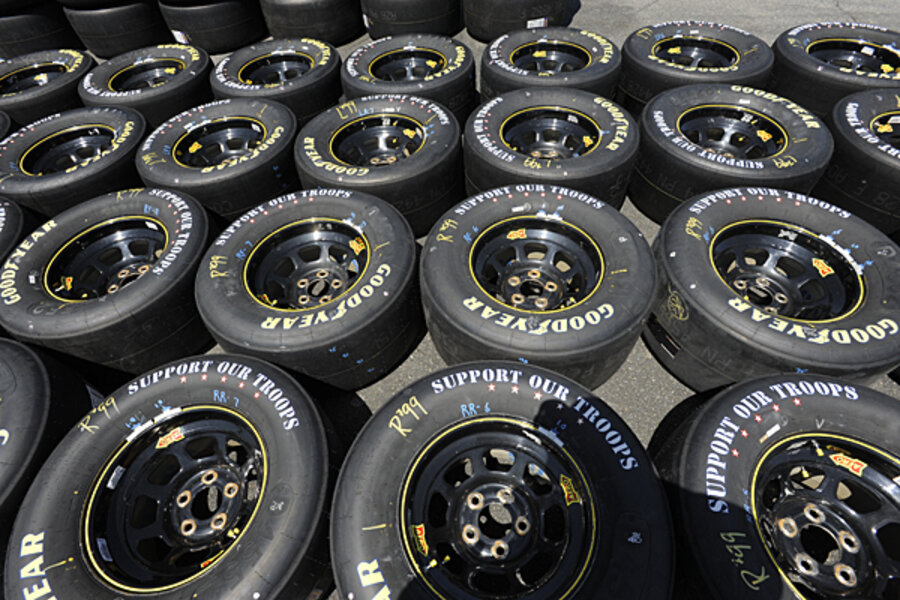Car safety: 7 tips for safe tires
Loading...
Tires aren't just treads we replace once every few years. They help us maneuver safely and avoid accidents; and the grip and security they provide is not to be taken lightly.
Each year, there are nearly 11,000 tire-related crashes, and nearly 200 people die each year from those crashes.
And according to the National Highway Traffic Safety Administration (NHTSA), the federal agency that oversees vehicle safety and tire safety, many of these crashes can be avoided simply by understanding tire maintenance, understanding tire labels, keeping track of the age of your tires, and monitoring recalls.
It's a matter of educating yourself about tires, and making sure that your friends and loved ones know, too; and there are some pointers that might not seem intuitive but could go a long way toward assuring your safety.
You probably know that you should be checking your tire pressure often—at least once a month, preferably when you haven’t driven the vehicle in at least three hours.
Starting with that, and distilling what we see as some very important points from a new “TireWise” campaign from NHTSA, take a look at the infographic here, then click through to find six more potentially life-saving tips to keep in mind.
Tires don’t just wear; they age. Most tires age to a point at which, at six to ten years, you can have ‘safe’ tread left yet the compound is no longer safe. Don’t wait for a blowout or tread separation before you decide to replace the tires on that older vehicle that you only take out once in a while. And yes, spares age, too.
Balance, align, rotate. Consult with your owner’s manual, and if it advises tire rotation, have it done at the recommended interval. That won’t produce any benefits you can immediately feel, but it will assure that your tires, as well as some driveline components, will last longer. And if you notice steering-wheel pulsation, or if your vehicle is pulling to the side when on a straight, mostly level road, take it in to your mechanic, or to a wheel and alignment expert.
Potholes can knock your pressure down. This isn’t one to take lightly either. After an unusually long, brutal winter for much of the U.S., and more snowfall than usual, many cities are in the midst of a pothole crisis. Even if there’s no vibration after an impact and the tire andwheel look intact, the jarring impact of a pothole can temporarily break the seal of a tire to the wheel, causing a sudden loss of some but not all of the pressure—in amounts that might not be enough to set off tire-pressure sensors. If hitting severe potholes is a daily occurrence, remember to check your tires—and tire pressure—as often as you can.
Study your tread. While damaged or improperly inflated tires that go too long unchecked can lead to suspension, steering, or driveline issues, the opposite can be the case, too, and serious safety issues with your own vehicle can show their first signs through your tires. Beyond the standard treadwear checks, like “the penny test,” look for fraying, scalloping, cupping, or any kind of uneven wear and take it as a life-saving warning sign.
Register your tires. This one’s extremely important, and too often skipped or overlooked. The National Highway Traffic SafetyAdministration issues about 20 tire recalls per year, and if you register your tires’ details (to receive e-mail recall notifications), you’re far less likely to miss a crucial safety issue. You can also file tire complaints independent of the federal government’s recall channels.
Buy the right tire for your needs in the first place. Understand that the safest tires might not always be the most fuel-efficient or the longest-lasting—and that specialty tires out of their element can be dangerous. For instance, the soft, summer-performance tires that arrive on some top-performance models are ill-suited for cold, wet roads. Likewise, using special winter tires year round are going to cost you some safety (and a lot of tread wear) if you try to use them in hot weather.
Buying your tires from an experienced professional is your best bet, of course; but learning about all the ways that tires are rated and labeling—with this Tire Buyer's FAQ—is a great start before you head there.







